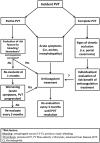Anticoagulant therapy in patients with liver cirrhosis and portal vein thrombosis: insights for the clinician
- PMID: 30202445
- PMCID: PMC6128073
- DOI: 10.1177/1756284818793561
Anticoagulant therapy in patients with liver cirrhosis and portal vein thrombosis: insights for the clinician
Abstract
Portal vein thrombosis (PVT) is a frequent complication in the natural history of patients with liver cirrhosis (LC). The prevalence of PVT in LC is highly variable, ranging from 0.6% to 25% according to different reports. The impact of PVT on the natural history of LC is unclear, but it seems to negatively affect the prognosis of patients undergoing liver transplantation (LT) by increasing post-LT mortality and delaying waiting time. The antithrombotic treatment of PVT is still challenging as PVT may often remain asymptomatic and incidentally diagnosed, and a spontaneous partial/total regression of PVT is observed in an important proportion of patients, even in the absence of anticoagulation. Recent evidence suggested that the anticoagulant treatment for PVT may favorably affect both ischemic and bleeding outcomes in LC patients. Anticoagulant therapies so far available include unfractioned heparin, low molecular weight heparins (LMWHs) and fondaparinux for acute treatment, and LMWHs and vitamin K antagonists (VKAs) for long-term treatment. No robust data currently support the use of direct oral anticoagulants (DOACs) in patients with LC and PVT, as the safety and efficacy of DOACs in this setting is still unclear. This review summarizes current evidence for the evaluation and management of patients with LC and PVT.
Keywords: DOACs; LMWH; VKAs; fondaparinux; liver cirrhosis; portal vein thrombosis.
Conflict of interest statement
Conflict of interest statement: The authors declare that there is no conflict of interest.
Figures
Similar articles
-
Anticoagulation outcomes in cirrhotic patients with portal vein thrombosis: a tertiary center study.Postgrad Med J. 2025 Apr 29:qgaf062. doi: 10.1093/postmj/qgaf062. Online ahead of print. Postgrad Med J. 2025. PMID: 40298249
-
Treatment of direct oral anticoagulants in patients with liver cirrhosis and portal vein thrombosis.Clin Mol Hepatol. 2021 Oct;27(4):535-552. doi: 10.3350/cmh.2021.0109. Epub 2021 Jun 16. Clin Mol Hepatol. 2021. PMID: 34130370 Free PMC article. Review.
-
Portal vein thrombosis in cirrhosis.J Clin Exp Hepatol. 2014 Dec;4(4):320-31. doi: 10.1016/j.jceh.2013.12.003. Epub 2013 Dec 31. J Clin Exp Hepatol. 2014. PMID: 25755579 Free PMC article. Review.
-
Usage of Direct Acting Oral Anticoagulants in Cirrhotic and Non-Cirrhotic Portal Vein Thrombosis: A Systematic Review.Cureus. 2021 Aug 5;13(8):e16922. doi: 10.7759/cureus.16922. eCollection 2021 Aug. Cureus. 2021. PMID: 34367844 Free PMC article. Review.
-
Portal vein thrombosis in cirrhotic patients - it is always the small pieces that make the big picture.World J Gastroenterol. 2018 Oct 21;24(39):4419-4427. doi: 10.3748/wjg.v24.i39.4419. World J Gastroenterol. 2018. PMID: 30356984 Free PMC article.
Cited by
-
Recurrent Left Ventricular Thrombus Formation on Rivaroxaban Therapy in Cardiomyopathy and Liver Cirrhosis.JACC Case Rep. 2020 Aug 19;2(10):1501-1504. doi: 10.1016/j.jaccas.2020.05.094. eCollection 2020 Aug. JACC Case Rep. 2020. PMID: 34317005 Free PMC article.
-
Clostridium Difficile and COVID-19: Novel Risk Factors for Acute Portal Vein Thrombosis.Case Rep Vasc Med. 2021 Feb 27;2021:8832638. doi: 10.1155/2021/8832638. eCollection 2021. Case Rep Vasc Med. 2021. PMID: 33728091 Free PMC article.
-
Pseudo-monoclonal gammopathy due to autoimmune disease: a case report.J Int Med Res. 2020 Feb;48(2):300060519866618. doi: 10.1177/0300060519866618. Epub 2019 Sep 25. J Int Med Res. 2020. PMID: 31550956 Free PMC article.
-
Protein S for Portal Vein Thrombosis in Cirrhotic Patients Waiting for Liver Transplantation.J Clin Med. 2020 Apr 20;9(4):1181. doi: 10.3390/jcm9041181. J Clin Med. 2020. PMID: 32326024 Free PMC article.
-
Tailored Practical Management of Patients With Atrial Fibrillation: A Risk Factor-Based Approach.Front Cardiovasc Med. 2019 Mar 12;6:17. doi: 10.3389/fcvm.2019.00017. eCollection 2019. Front Cardiovasc Med. 2019. PMID: 30915342 Free PMC article. Review.
References
-
- Ferro D, Angelico F, Caldwell SH, et al. Bleeding and thrombosis in cirrhotic patients: what really matters? Dig Liver Dis 2012; 44: 275–279. - PubMed
-
- Lai CH, Cheng PY, Chen YY. Liver cirrhosis and risk of intracerebral hemorrhage: a 9-year follow-up study. Stroke 2011; 42: 2615–2617. - PubMed
-
- Basili S, Raparelli V, Napoleone L, et al. Platelet count does not predict bleeding in cirrhotic patients: results from the PRO-LIVER study. Am J Gastroenterol 2018; 113: 368–375. - PubMed
-
- Lisman T, Violi F. Cirrhosis as a risk factor for venous thrombosis. Thromb Haemost 2017; 117: 3–5. - PubMed
-
- Raparelli V, Basili S, Carnevale R, et al. Low-grade endotoxemia and platelet activation in cirrhosis. Hepatology 2017; 65: 571–581. - PubMed
Publication types
LinkOut - more resources
Full Text Sources
Other Literature Sources


